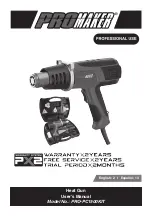
12
OPERATING SPEEDS
This tool is a high speed multitool. The digital display of the 400
Series DIGITAL tool shows the exact number of RPM (x 1.000)
at which the tool is running. To increase / decrease the speed
push the speed up / down buttons. The speed of your multitool
can be increased and decreased in 1.000 RPM increments. This
allows you to control the speed of your multitool very accurately.
Adjusting the no. of RPM to your project will give a better end
result. To achieve the best results
when working with different materials, set the variable speed
control to suit the job. To select the right speed for the accessory
in use, practice with scrap material fi rst.
NOTE: Speed is affected by voltage changes. A reduced incoming
voltage will slow the RPM of the tool, especially at the lowest
setting. If your tool appears to be running slowly, increase the
speed setting accordingly. The tool may not start at the lowest
switch setting in areas where outlet voltage is less than 220 volts.
Simply move the speed setting to a higher position to begin
operation.
Refer to the Speed Settings chart on pages 4-6 to help
determine the proper speed for the material being worked on
and the accessory to use.
A) For use on drywall. For best results use at 33.000 RPM.
B) For use on wall and fl oor grout. Use setting 20.000-28.000
RPM.
*) Speed for light cuts. Caution, burning on deep grooves
possible.
■
) Depending on cutting direction relative to grain.
Most jobs can be accomplished using the tool at the highest
setting. However, certain materials (some plastics and metals)
can be damaged by high-speed generated heat and should
be worked on at relatively low speeds. Low speed operation
(15,000 RPM or less) is usually best for polishing operations
employing the felt polishing accessories. All brushing
applications require lower speeds to avoid wire discharge from
the holder. Let the performance of the tool do the work for you
when using lower speed settings. Higher speeds are better for
hardwoods, metals and glass and for drilling, carving, cutting,
routing, shaping and cutting dadoes or rabbets in wood.
Some guidelines regarding tool speed:
• Plastic and other materials that melt at low temperatures
should be cut at low speeds.
• Polishing, buffi ng and cleaning with a wire brush must be
done at speeds not greater than 15,000 RPM to prevent
damage to the brush and your material.
• Wood should be cut at high speed.
• Iron or steel should be cut at high speed.
• If a high speed steel cutter starts to vibrate, it usually
indicates that it is running too slow.
• Aluminium, copper alloys, lead alloys, zinc alloys and tin
may be cut at various speeds, depending on the type of
cutting being done. Use a paraffi n (not water) or other
suitable lubricant on the cutter to prevent the cut material
from adhering to the cutter teeth.
NOTE: Increasing pressure on the tool is not the answer when it is
not performing properly. Try a different accessory or speed setting
to achieve the desired result.
MAINTENANCE
Preventative maintenance performed by unauthorized personnel
may result in misplacing of internal wires and components which
could cause serious hazard. We recommend that all tool service
be performed by a Dremel Service Facility. To avoid injury from
unexpected starting or electrical shock, always remove plug from
wall outlet before performing service or cleaning.
CARBON BRUSHES
The brushes in your tool have been engineered for many hours
of dependable service. To prepare the brushes for use, run the
tool at full speed for 5 minutes under no load. This will properly
"seat" the brushes, and extend the life of the tool. To maintain
peak effi ciency of the motor, examine the brushes for wear every
40-50 hours.
Using the tool with worn brushes will permanently damage the
motor.
Use only original Dremel replacement brushes.’ Inspect
the multitool brushes after 40-50 hours of use. If the multitool
runs erratically, loses power, or makes unusual noises check the
brushes for wear and possible replacement. Follow these steps
to check/change the multitool brushes:
1. With the power cord unplugged, place the tool on a clean
surface. Use the tool wrench to remove the brush caps.
PICTURE 8.
2. Turn the tool so that the brush falls out of the holder and check
each brush. If the brush is less than 3mm long and the surface
of the brush that touches the commutator is rough or pitted,
the carbon brushes should be replaced. Be sure to check both
brushes. PICTURE 9
3. If one brush is worn, you should replace both brushes for
better performance of your multitool. Remove the spring
from the brush, throw away the old brush and place the
spring on a new brush.
4. Place the carbon brush and spring back into the tool, there
is only one way the brush will fi t back into the tool. Make
sure the brushes are installed as illustrated. PICTURE 9 The
curved surface of the brush must match the curvature of the
commutator.
5. Rest squared unterside of the brush door on the squared
cavity openings. Check to be sure the spring rests on the
V groove of the brush. Push the front of the door down.
The push down and snap the rear latch into its slot. After
replacing the brushes the tool should be run at no load;
place it on a clean surface and run it freely at full speed for
5 minutes before loading (or using) the tool. This will allow
the brushes to "seat" properly and will give you more hours
of life from each set of brushes. This will also extend the
life of your tool since the commutator surface will also wear
better and longer. PICTURE 10
V
8448 manual Dremel 400S Cen-Nor.12 12
8448 manual Dremel 400S Cen-Nor.12 12
21-4-2008 11:58:02
21-4-2008 11:58:02













































